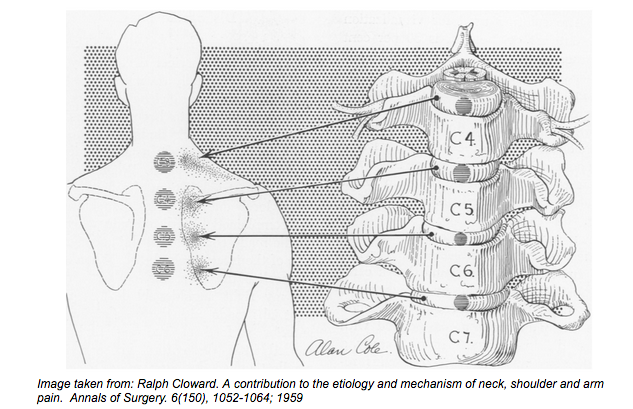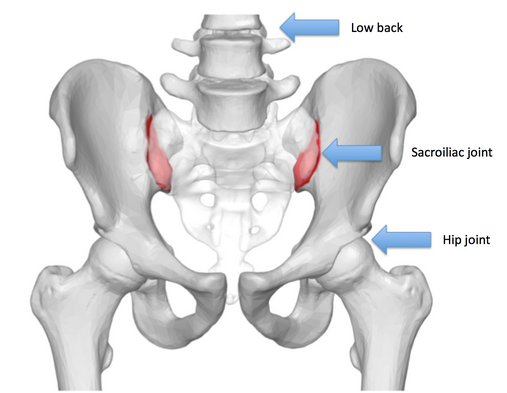When evaluating a patient, providers need to know exactly where the pain starts and potentially radiates in the body. The components of a pain history are location, quality, intensity, aggravating and alleviating factors. The most basic is location.
 Cervical
Cervical
Neck pain very often is midline in the neck or slightly lateralized to the muscles on the right or left side. Neck arthritis pain may radiate to the base of the skull, causing headaches. Headaches in general, however, may be caused by a variety of etiologies. Neck arthritis commonly radiates between the shoulder blades. Many patients think they have thoracic or mid-back problems, however this is usually just radiation from the neck.
If a nerve is being pinched in the neck, arm symptoms may develop. Different nerves radiate to different areas of the arm and hand, so the location of the symptoms may give an excellent clue to which spinal level is the problem.
Lumbar
Low back pain, in contrast, has a few imposters which makes diagnosis a little more difficult. Hip pain may start on the outside of the upper leg over the femoral head. We lay on our hips when laying on our sides. Hip pain can radiate to the low back or upper leg. It tends not to extend above the belt line and rarely past the knee. It commonly radiates into the groin.
 The sacroiliac (SI) joint is where the sacral bone attaches to the pelvis. SI pain may also extend into the low back and down the hamstring, but it is typical over the medial upper buttocks. It also rarely radiates past the knee. SI pain may be worse when sitting or laying on the left buttock. It is painful when moving from sitting to standing.
The sacroiliac (SI) joint is where the sacral bone attaches to the pelvis. SI pain may also extend into the low back and down the hamstring, but it is typical over the medial upper buttocks. It also rarely radiates past the knee. SI pain may be worse when sitting or laying on the left buttock. It is painful when moving from sitting to standing.
Low back pain commonly is present in the middle low back or lateralizes to the paraspinal muscles. It may radiate to the buttocks, which many patients mischaracterize as their “hips”. Just as in the cervical spine, lumbar arthritis may cause symptoms down the legs, in a specific distribution. In layman’s terms, this may be called “sciatica”. The sciatic nerve is a conglomeration of multiple lumbar nerve roots extending down the leg. The L4, L5 and some sacral nerves comprise the sciatic nerve, so compression at L3-4, L4-5 or L5-S1 spinal levels could cause “sciatica”. However the L4, L5 and S1 nerves radiate to different areas on the leg/ foot, so a careful exam may give a clue to which nerve may be pinched.
When evaluating a patient, it is crucial for providers to find out exactly where the pain starts and potentially radiates in the body. As a patient may have arthritis in multiple different places, the localization of pain helps to isolate whichever area is causing the majority of symptoms.






